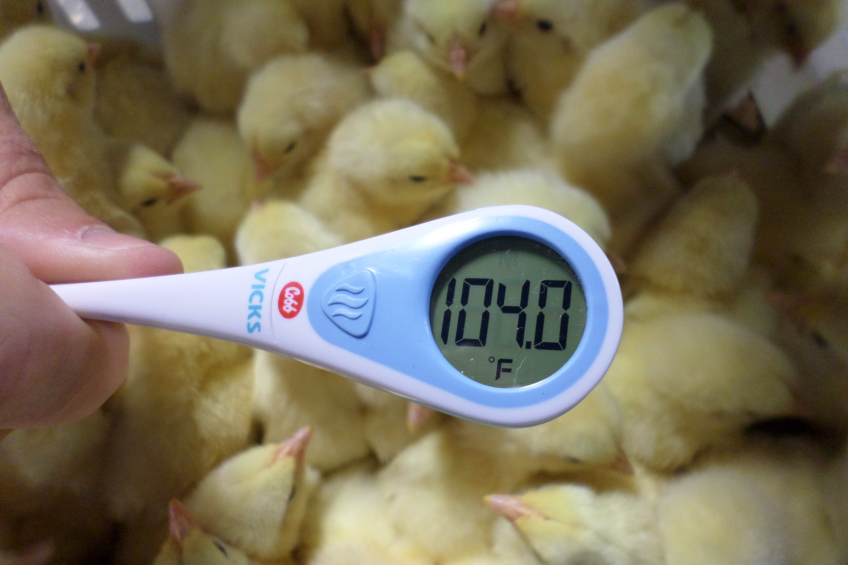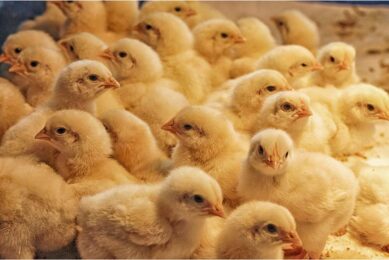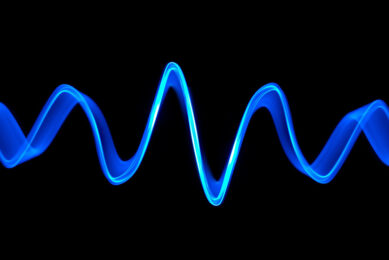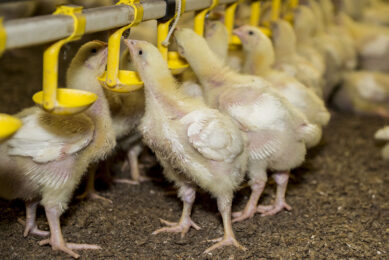Avoiding overheating day-old chicks

The first few days of a baby chick’s life are ?vitally important to overall broiler performance. When chicks are overheated at the hatchery, this can seriously detract from their genetic potential.
To avoid overheating day-old chicks and prevent possible damage, hatchery personnel have to develop a keen eye for the signs that chicks are indeed overheated. Three questions that have to be answered lie at the basis of delivering healthy chicks to the customer time after time. What are the signs that chicks are overheated? What procedures can be put in place to identify possible overheating? And what can be done to prevent this overheating? These key indicators can help a hatchery identify when chicks are overheating, and so help improve chick quality and overall broiler performance.
Smaller chicks with larger, non-absorbed yolk sacs are an indication chicks have been overheated. The yolk sac is the life blood of the chick at the beginning of its life. This sac contains proteins, lipids, water and antibodies and its absorption is vital to the chick. If chicks become overheated, this absorption can be slowed or completely stopped.
A procedure to judge whether proper yolk sac absorption has occurred is YFBM (Yolk Free Body Mass). To do this weigh each chick in the study individually, and record the body weight in grams. Then properly euthanise the chick to be able to completely remove the yolk sac. Weigh each yolk sac in grammes. Make sure to keep the corresponding yolk sac of each chick separate, knowing which yolk sac came from which chick. Take the yolk sac weight and divide it by the chick weight to indicate a percentage. For example, a 4.4 gram yolk sac / 47.8 gramme chick will yield a percentage of 9.21%. The desired percentage for proper yolk sac absorption is 10%. If the percentage is much greater than 12%, this could be a sign that the chicks were overheated and have not attained proper absorption of the yolk sac.
Check temperature multiple times
When a chick is hatched the ideal internal body temperature should be between 103.5°F and 104.5°F (39.5° and 40.5° Celsius). To measure this temperature it is recommended that a rectal thermometer be used. Also check this temperature multiple times throughout the hatch process.
There are three different areas where this check can be done: During prepull assessment, chick pull time/dispatch and arrival at the farm. A prepull assessment is conducted at 24, 18, 12, and 6 hours before the actual pulling of the chicks from the hatchers. This is a good time to take the internal body temperature of several chicks as this period of the chick’s life is a critical time to avoid overheating.
A good method to avoid overheating is a hatcher step-down programme, which is designed to lower the air temperature in the hatcher as the process is progressing. The key to is to begin just before the chicks reach 104°F (40°C) internal body temperature. As the chick’s core body temperature increases, we decrease the air temperature in the hatcher. The chicks will dictate when and how much this temperature can be turned down. Use of the rectal thermometer will indicate when the core temperature is increasing. To lower this temperature the damper on the hatcher will begin opening more if it is not already programmed into the automatic hatcher profile.
Some hatchers have the ability to run such a programme for automatic damper opening. In this case the following is recommended: 24 hours before pull at least 50% opening, at 18 hours before pull at least 75% opening and 12 hours before pull complete opening. If the hatcher system has no programme for minimum damper opening, check the position of the damper at the various times so that the settings provide adequate fresh air to the chicks as they hatch from the egg shells.
Additional steps
If the core body temperature is still elevated, two additional steps can be taken. When the temperature in the hatcher is lowered to its minimum allowable setting, lower the temperature in the hatcher hallway to help provide cooler intake air. This programme can also be stepped down to allow the chicks to remain at 104°F.
The last step is to increase the negative pressure setting in the exhaust plenum of the hatcher. This will force additional air into the machine providing additional cooling ability. Increasing this negative pressure too much can lead to a bypassing effect of the air to the chicks while in the hatchers. This is where instead of circulating through as designed, the air passes directly through the hatcher and is not distributed correctly in the cabinet.
It is important to follow these steps in this precise order — adjusting hatcher air temperature, hallway room conditions and lastly increasing negative plenum pressure. In such a step programme, monitor the chicks closely, taking their internal body temperature to see whether you need to move to the next step or whether the step progression has been too fast.
5 percent rule
When the chicks reach the correct time to be pulled, a good general rule of thumb is that 5% of the chicks should have a dark, discoloured, wet looking area behind their head on the nape of their neck. This is a good indication that the chicks have hatched within the desired incubation time. Using the rectal thermometer during the chick pull process can indicate if overheating is occurring during this rather frenzied process. Hatcher trolleys of chicks are often placed too close together in a confined space and the internal temperature of the chick can rise quickly and cause overheating.
This area where the chicks are removed from the hatcher trays should have adequate air distribution and circulation. When the chicks reach the chick box for transportation, the same procedure should be followed regarding air distribution and circulation. The chicks should be placed in an adequately ventilated area, where their internal body temperature will not rise. The thermometer can be used before chick dispatch, during transport and once the chicks arrive at the farm. If the internal body temperature of a chick reaches 106°F (41°C), the chick will begin to pant.
Too high internal temperatures can lead to chicks becoming more susceptible to Colibacillosis or E. Coli. Colibacillosis can be found in the hatch debris and chick fluff, so contributing to bacterial infection which is why it is important to follow good hygiene during hatchery waste disposal to help prevent infection. WP













